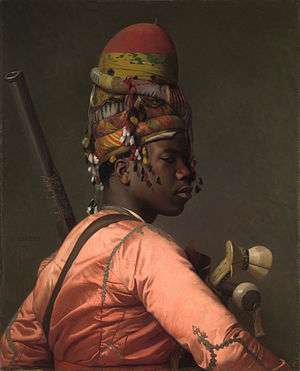Bashi-bazouk
A bashi-bazouk (Ottoman Turkish: باشی بوزوق başıbozuk, IPA: [baʃɯboˈzuk], lit. 'one whose head is turned, damaged head, crazy-head', roughly "leaderless" or "disorderly") was an irregular soldier of the Ottoman army, raised in times of war. The army chiefly recruited Albanians and Circassians as bashi-bazouks,[1] but recruits came from all ethnic groups of the Ottoman Empire.[2] They had a reputation for bravery, but also as an undisciplined group, notorious for looting and preying on civilians as a result of a lack of regulation.[1][3]
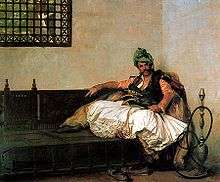 Bashi-Bazouk Chieftain by Jean-Léon Gérôme, 1881. | |
| Founded | 17th century |
|---|---|
| Named after | Turkish word for crazy-head |
| Founding location | Istanbul, Ottoman Empire |
| Years active | unknown |
| Territory | Balkans, Eastern Europe |
| Allies | Ottoman Empire Khedivate of Egypt Crimean Khanate |
| Rivals | Russian Empire Austro-Hungarian Empire British Empire Polish–Lithuanian Commonwealth Greece Serbia Romania Bulgaria |
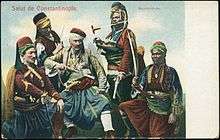
Origin and history
Although the Ottoman armies always contained mercenaries as well as regular soldiers, the strain on the Ottoman feudal system caused mainly by the Empire's wide expanse required heavier reliance on irregular soldiers. They were armed and maintained by the government, but did not receive pay and did not wear uniforms or distinctive badges. They were motivated to fight mostly by expectations of plunder.[4] Though the majority of troops fought on foot, some troops (called akinci) rode on horseback. Because of their lack of discipline, they were incapable of undertaking major military operations, but were useful for other tasks such as reconnaissance and outpost duty. However, their uncertain temper occasionally made it necessary for the Ottoman regular troops to disarm them by force.[3]
The Ottoman army consisted of the following:
- The Sultan's household troops, called Kapıkulu, which were salaried, most notable being Janissary corps.
- Provincial soldiers, which were fiefed (Turkish Tımarlı), the most important being Timarli Sipahi (lit. "fiefed cavalry") and their retainers (called cebelu lit. armed, man-at-arms), but other kinds were also present.
- Soldiers of subject, protectorate, or allied states (the most important being the Crimean Khans)
- Bashi-bazouk usually did not receive regular salaries and lived off loot.
An attempt by Husrev Pasha to disband his Albanian bashi-bazouks in favor of his regular forces began the rioting which led to the establishment of Muhammad Ali's Khedivate of Egypt.[5] Their use was abandoned by the end of the 19th century. However, self-organized bashi-bazouk troops still appeared later.
The term "bashibozouk" has also been used for a mounted force, existing in peacetime in various provinces of the Ottoman Empire, which performed the duties of gendarmerie.
Reputation and atrocities
The bashi-bazouk were notorious for being violently brutal and undisciplined,[6] thus giving the term its second, colloquial meaning of "undisciplined bandit" in many languages. A notable example of this use is in the comic series The Adventures of Tintin, where the word is often used as an expletive by Captain Haddock.[7]
The Batak massacre (1876) was carried out by thousands of bashi-bazouks sent to quell a local rebellion. Likewise, the bashi-bazouks perpetrated the massacre of Phocaea in 1914. During the 1903 Ilinden Uprising in Ottoman Macedonia, these troops burnt 119 villages and destroyed 8400 houses, and over 50,000 Macedonian refugees fled into the mountains.[8]
The Bulgarian martyresses (1877) by Konstantin Makovsky is a painting depicting the rape of two Bulgarian women in a church by one African-looking and two Turkish-looking bashi-bazouks, during the April Uprising.[9]
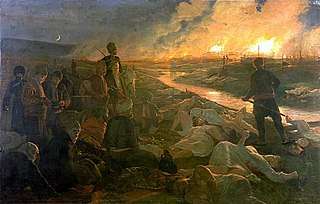 Bashibazouk carry out the Batak massacre.
Bashibazouk carry out the Batak massacre.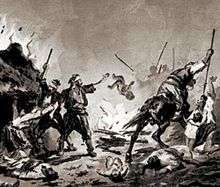 Bashi-bazouks' atrocities in Ottoman Bulgaria.
Bashi-bazouks' atrocities in Ottoman Bulgaria.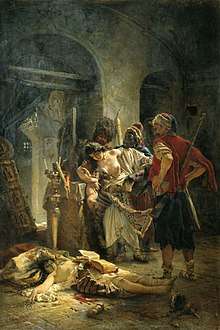 The Bulgarian martyresses.
The Bulgarian martyresses.
See also
- Mercenary
- Pindari, irregular horsemen in 18th-century India
- Black and Tans
References
- Houtsma 1993, p. 670.
- Vizetelly 1897, p. 83.
- Chisholm, Hugh, ed. (1911). . Encyclopædia Britannica (11th ed.). Cambridge University Press.
- Montgomery 1968, p. 246
- Inalcık, Halil. Trans. by Gibb, H.A.R. The Encyclopaedia of Islam, New Ed., Vol. V, Fascicules 79-80, pp. 35 f. "Khosrew Pasha". E.J. Brill (Leiden), 1979. Accessed 13 Sept 2011.
- ”[T]he faintest stirrings would unloose a whirling of janissaries and spahis and later on, and perhaps the worst, bashi-bazouks. They adorned the towns with avenues of gibbets, the burnt villages with pyramids of heads and the roadsides with impaled corpses." Fermor, Patrick Leigh, "The Broken Road," at 21 (John Murray, 2013)(ISBN 9781590177549).
- Horatio Clare (11 March 2008). Running for the Hills: A Memoir. Simon and Schuster. pp. 168–. ISBN 978-0-7432-7428-9.
- Glenny, Misha (2012). The Balkans. USA: Penguin Books. p. 205. ISBN 978-0-14-242256-4.
- Alexis Heraclides; Ada Dialla (2015). Humanitarian Intervention in the Long Nineteenth Century: Setting the Precedent. Oxford University Press. pp. 185–. ISBN 978-0-7190-8990-9.
Sources
| Wikimedia Commons has media related to Bashi-bazouk. |
- Edward Vizetelly (1897). The Remininiscences of a Bashi-bazouk. J.W. Arrowsmith.
- Ottoman warfare, 1500–1700 by Rhoads Murphey. London : UCL Press, 1999.
- Özhan Öztürk (2005). Karadeniz (Black Sea): Ansiklopedik Sözlük. 2 Cilt. Heyamola Yayıncılık. İstanbul. ISBN 975-6121-00-9.
- Montgomery, Viscount Bernard (1968). A History of Warfare, The World Publishing Company. ISBN 978-0-688-01645-6.
